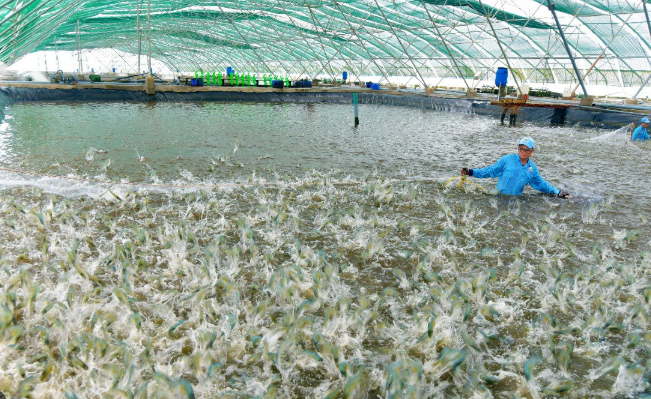(seafood.vasep.com.vn) In response to climate change and increasing market demands for sustainable aquaculture, the province of Cà Mau is scaling up its improved extensive shrimp farming model, which has proven both economically and environmentally effective.

Leveraging natural advantages to enhance product value
Cà Mau has been restructuring its shrimp sector to align with value chain development. The province encourages the formation of cooperative groups, cooperatives, and shrimp farming clubs to improve access to capital and technical assistance. As a result, the improved extensive farming model has been widely adopted by local farmers.
In Thới Bình district, over 32,000 hectares are under extensive shrimp farming, of which about 17,000 hectares apply the improved high-yield model. Farmers have seen clear benefits from using this model, including greater application of scientific techniques, reduced production risks, improved environmental protection, and better-quality shrimp.
Mr. Trần Văn Giới, a farmer in Tân Phú commune, successfully implemented the two-phase improved extensive model on a 2-hectare farm. He stocked 30,000 domesticated black tiger shrimp postlarvae and harvested over 450 kg of shrimp after just over three months. The shrimp reached sizes of 15–16 count/kg. After deducting costs, his net profit exceeded VND 80 million per crop—significantly higher than traditional methods.
Low-cost, farmer-friendly practices
The improved extensive model retains many characteristics of traditional shrimp farming—such as low stocking density, minimal chemical input, and reliance on natural feed sources—while introducing refinements like better seed management, scheduled mineral and probiotic supplementation, and occasional direct feeding. Importantly, implementation costs remain low at just a few hundred thousand dong per hectare, making the model accessible to small-scale farmers.
This model not only reduces production costs but also contributes to environmental improvements by minimizing waste discharge, improving water quality, and promoting clean, green farming practices.
Toward sustainable production and value chain integration
As of 2025, Cà Mau has developed approximately 127,600 hectares of improved extensive shrimp farming linked to value chains, involving over 64,800 households. Average yields reach 550 kg/ha/year, with a projected total output of nearly 71,000 tons for the year.
To further improve efficiency, the province is investing in infrastructure, piloting demonstration farms, upgrading broodstock and input quality, and providing suitable financial support. At the same time, technical training, extension services, and science-based production methods are being promoted.
The Department of Agriculture and Rural Development is encouraging cooperative-based production through access to land, credit, digital technology, and branding support. Cooperatives are being supported to apply safe, organic, and good aquaculture practices (GAP) to meet market demands and enhance product value.
Planning efforts are also underway to consolidate improved extensive farming areas into concentrated production zones, especially in shrimp–mangrove and rice–shrimp ecosystems. These areas are being developed in line with organic and sustainable farming orientations.
With strong local engagement and favorable environmental conditions, Cà Mau’s improved extensive shrimp farming model is emerging as a viable path toward sustainable aquaculture development and improved rural livelihoods.